As an Amazon Associate I earn from qualifying purchases.
This is an old school, slow roast duck recipe, the way your grandma might have made. If you have a store-bought duck or a really fat wild duck, this is the recipe for you.
Roasting a duck this way will give you crispy skin, much of the fat will render out, bathing the root vegetables underneath, and the whole bird will be cooked through.
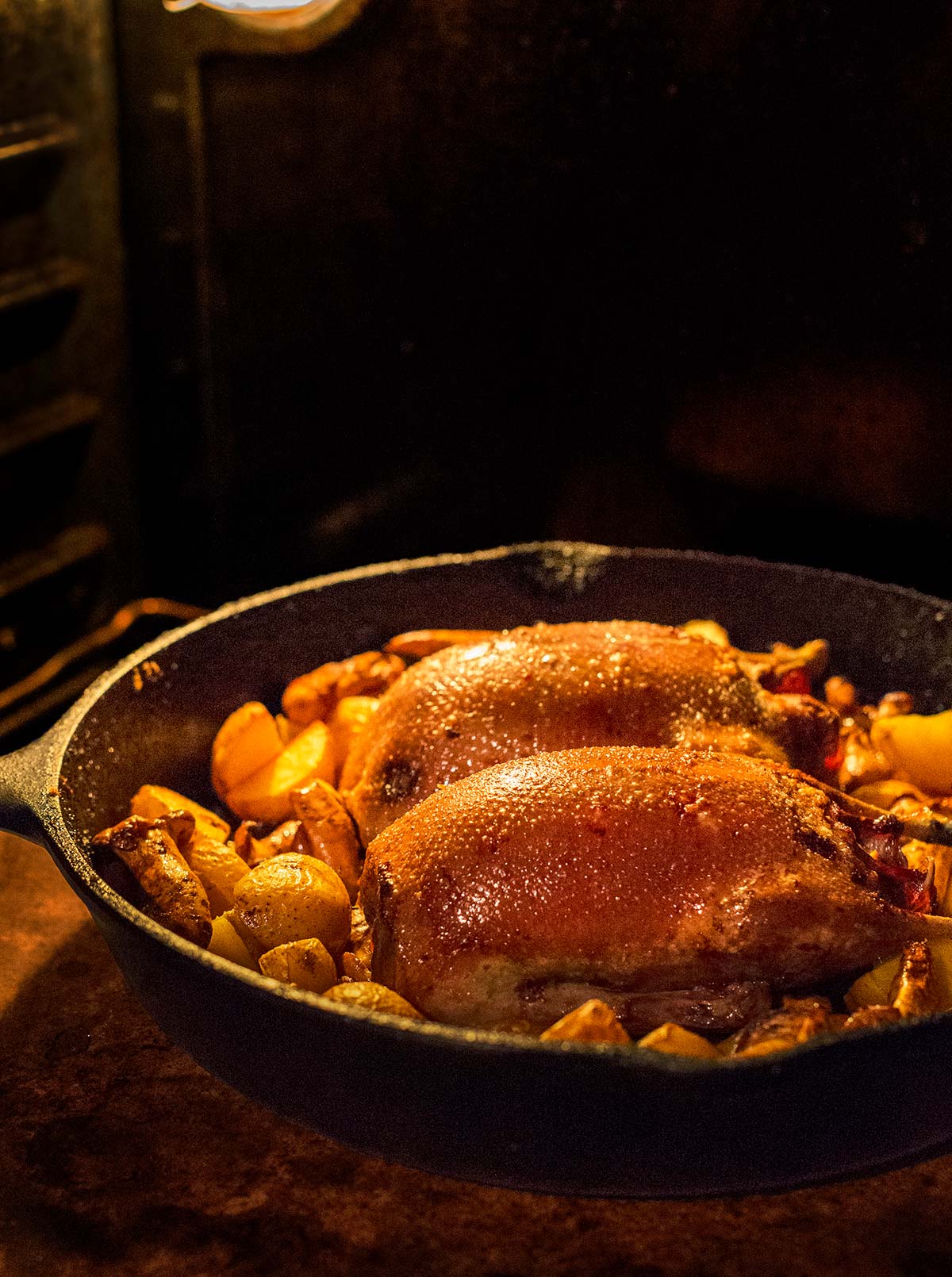
This is how pretty much everyone made roast duck until relatively recently, when the glories of duck served medium or medium-rare began to be more well-known. Yes, you can absolutely serve duck — or goose — rare, or even raw, if it’s of good quality. Food-borne illnesses from waterfowl are very, very rare, unlike with chickens and turkeys.
So if you happen to have a wild duck, or a lean farmed duck — Indian runners and Muscovy ducks can sometimes be quite lean — you are better off using my other recipe for roast duck, which is geared specifically for lean, and wild birds.
This method, slow roast duck, is the way all of Europe has been doing it for millennia, so there’s some history here. I go into it in more detail in my cookbook Duck, Duck, Goose: The Ultimate Guide to Cooking Waterfowl, Both Farmed and Wild, an entire cookbook dedicated to waterfowl.
The reason it works is fat. Fat is an insulator, and in a duck it’s all underneath the skin. You need to render that fat or the skin will never get crispy. And rendering fat from an obese duck takes time — so much time that your breast meat will be fully cooked by the time it’s ready (The legs and wings will be perfect, though).
I should tell you that I don’t love fully cooked breast meat; I prefer it medium-rare. It gets a bit livery and, at least to my mind, essentially becomes a vehicle for gravy.
You can do two things about this: You can slice off the breasts when they reach an internal temperature of about 135°F, then sear just the skin side in a pan before serving, or you can live with fully cooked breast meat and make a damn good gravy. (Follow the technique for the gravy in my poached turkey recipe, only subbing in duck or goose bits.)
Even fully cooked, the breast meat will still be moist because it’s been bathed in its own fat for an hour or more, so it’s not as if it will be inedible. And some people prefer it that way.
A few tips: Do not cover your duck when roasting because you want that crispy skin. If you cover it, the bird will steam.
And, you will know a roast duck is ready when the legs feel loose, the fat runs clear, and the skin is crispy.

With this recipe, err on cooking the bird longer, not shorter. As the cook, remember that the legs and wings will be the best parts. Distribute them accordingly.
My advice for when you make slow roast duck this way is to roast them over the top of lots of root vegetables, the more varied the better. And think about a gravy or a sauce to go with it. I have a large selection of wild game sauces here you can choose from. Other than the gravy I mentioned above, I might suggest the maple-bourbon gravy for starters…
Slow Roast Duck
Ingredients
- 1 domesticated duck or 2 very fat wild ducks (see above)
- 1 tablespoon kosher salt
- 1 lemon, cut in half
- 4 sprigs sage, rosemary, parsley or thyme
Instructions
- Set your oven to 325°F. Using a needle or a sharp knife point, prick the skin of the duck all over -- but be sure to not pierce the meat itself, only the skin. This lets the fat render out and will help crisp the skin. Pay special attention to the back, the flanks, and the very front of the breast.
- Rub the cut lemon all over the duck and stick it inside the cavity. Liberally salt the bird; use a little more salt than you think you need. Stuff the duck with the herbs. Let the bird sit out for about 30 minutes to come to room temperature, while the oven heats up.
- When you are ready to roast, put the duck in an iron frying pan or other ovenproof pan and surround it with root vegetables. Set the pan in the oven. Small ducks (wood ducks, wigeon, teal, ruddies, etc.) only need 40 minutes in the oven. If you are roasting mallards or a typical, store-bought Pekin duck, you will want to increase the roasting time to 90 minutes. A goose may take as long as 2 hours. After the allotted time, take the pan out of the oven and set the ducks on a cutting board to rest. Spoon any fat that has accumulated over the vegetables and salt them well. If the veggies are ready to eat, remove them. If there is a lot of excess fat, spoon it off.
- Now increase the heat to 450°F. When the oven hits this temperature, return the birds to the oven and roast them for up to 30 more minutes, or until the skin is crisp. The reason you take the bird out of the oven is because a) the resting time helps redistribute the juices in the bird midstream, and b) you are crisping skin without totally overcooking the duck by only returning it to the oven when it is hot.
- Remove from oven and let the birds rest. Small ducks need 5 minutes resting time, large ducks 10 minutes, geese 15.
Nutrition
Nutrition information is automatically calculated, so should only be used as an approximation.

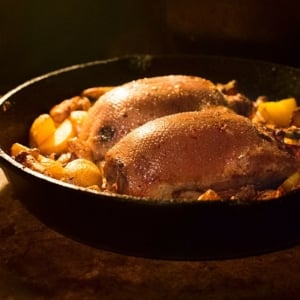
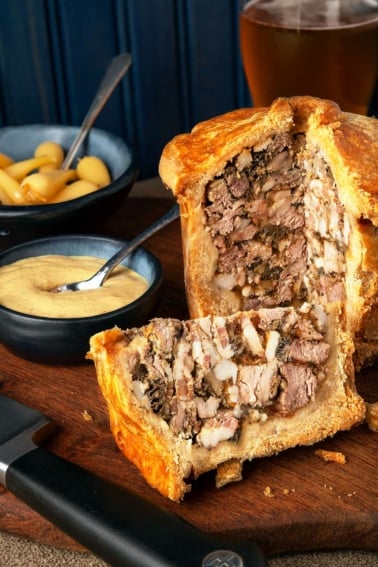
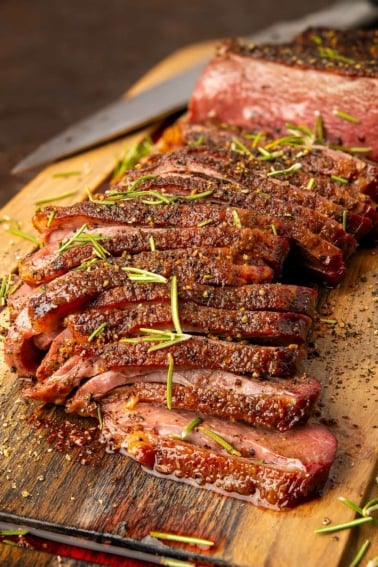
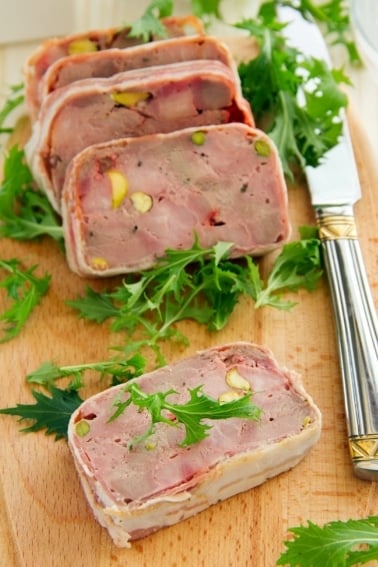
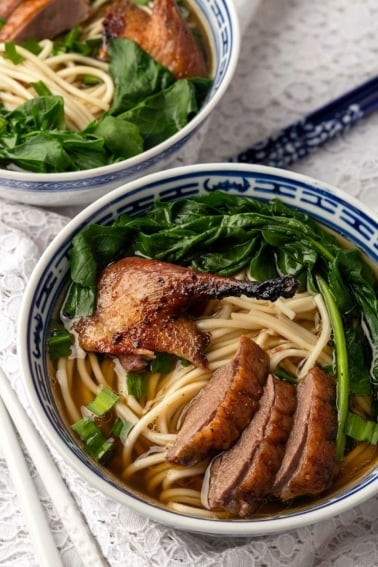
Duck skin was not crisp . We were sad. But the dog was happy .
Thank you for this recipe! simple and delicious!
I have used this recipe and minor variations of it many times. It consistently results in an excellent roast duck. Although I agree with Hank about the breasts being better seared medium rare, in my opinion they still turn out really good with this method. I’ve never found them livery or heard anyone complain about them and I think they are a good bit better than Turkey breasts usually turn out. I often do ducks on Thanksgiving and far prefer slow roasted European style duck, or goose, to almost any Turkey preparation. Although I have cut them off and finished the breasts separately a few times, usually I find that to be too much trouble since they still turn out good roasted, even if less than optimal. As far as the compromises of life go, I can usually live with fully cooked duck breast 🙂
Roasted another (store bought) duck tonight for Christmas this year using this as a guideline (Christmas season ends 6 January–12 days of Christmas, after all!) . It’s been a new “family tradition” for the past three years, using these guidelines each time, and each has turned out great. This third year is no exception!
Looking forward to the duck soup with the carcass this weekend!
Thanks, and merry Christmas and happy new year!
This simple recipe has drastically improved the quality of my waterfowl cooking.
Making this recipe for the second time with pintails, basically foolproof and works amazingly, thank you Hank your resources are invaluable and I’m a professionally trained chef????
I roasted my first duck yesterday for Thanksgiving for two, using this technique. I made a couple of adjustments, like made a dry rub of 3/1 kosher salt and brown sugar mixed with the zest of an orange and a T. of lavender blossoms, pricked the duck skin and rubbed that in inside and out, then refrigerated uncovered for 24 hrs. I rinsed most of that off and dried the duck before bringing it to room temp and proceeding with the recipe (didn’t add additional salt). I used convection at 325 for 1 hour, removed the half-cooked veggies and the fat, turned up the oven and returned the duck to the hot oven for 30 min. But my duck exuded another 3/4cup of fat during this phase, and though wonderfully browned, the skin was not crisp. It looked beautiful and tasted incredible, but there was still significant fat under the skin, so most of the skin couldn’t be eaten. Also, just a note, I started out to make the Bourbon Maple gravy, but when it came time to add the Bourbon I decided it would taste too boozy, so I used dry Marsala instead, and also just 1 T. of Maple syrup. It worked well with the bread dressing and the duck. We definitely want to do this again, but I wonder whether I should extend the 1st or 2nd cooking phase? How do I know when the duck fat has all been rendered? Thanks for a great cooking and dining experience!
I substituted Herbs de Provence instead of the herbs called for in this recipe. The domestic duck still came out excellent! I used an oven thermometer in the breast and removed it from the 450F oven when the internal temperature hit 150F knowing that the temperature would still rise after. In retrospect, I probably should have let it hit 155F to remove that last bit of redness.
Nothing like a classic roasted duck! My bad on leaving it in a little too long. The low cooking temperature then the hot crisping of the sink it spot on. If you want to be brought back to meals with family during the holidays, this will do it!
Years ago I bought Hank Shaw’s book Duck Duck Goose. This was the first recipe I tried. It was simply amazing. If you’re a beginner waterfowl cook this is a good place to start. Every year I try to make something new from Hank’s book. However, I will always cook at least 1 duck using this recipe.
My duck is almost 8 lbs. how long to cook this bad boy?
We had a duck breast given to us and im not too sure how to cook it.
Can it be done in a slow cooker or not..? what is your best recipe for this,
please?
Rose: Do not cook a duck breast in a slow cooker. Cook it like a steak.
Cooked a five-pound duck on a rotisserie in a gas grill. Came out excellent.
This turned out really well. I did rotate the duck after 30 minutes and basted it a bit. It was delicious and very flavorful, cooked perfectly, not overdone. I did a lot of research to find a good recipe and glad I chose this one!
First time roasting a duck. Recipe, roasting instructions spot on. Delicious! Thank you.
We cooked a 5lb store bought duck following this recipe and it was excellent! The meat wasn’t over cooked and the skin was marvelously crispy.